CONTENTS OF THIS TEMPLATE
Here’s what you’ll find in this Slidesgo template:
1.A slide structure based on a learning center presentation, which you can easily adapt to your needs. For more info on how to edit the template, please visit Slidesgo School or read our FAQs.
2.An assortment of illustrations that are suitable for use in the presentation can be found in the alternative resources slide.
3.A thanks slide, which you must keep so that proper credits for our design are given.
4.A resources slide, where you’ll find links to all the elements used in the template.
5.Instructions for use.
6.Final slides with:
7.The fonts and colors used in the template.
8.A selection of illustrations. You can also customize and animate them as you wish with the online editor. Visit Stories by Freepik to find more.
9.More infographic resources, whose size and color can be edited.
10.Sets of customizable icons of the following themes: general, business, avatar, creative process, education, help & support, medical, nature, performing arts, SEO & marketing, and teamwork.
You can delete this slide when you’re done editing the presentation.
Res Judicata
Section -11
No Court shall try any suit or issue in which the matter directly and substantially in issue has been directly and substantially in issue in a former suit between the same parties, or between parties under whom they or any of them claim, litigating under the same title, in a Court competent to try such subsequent suit or the suit in which such issue has been subsequently raised, and has been heard and finally decided by such Court.
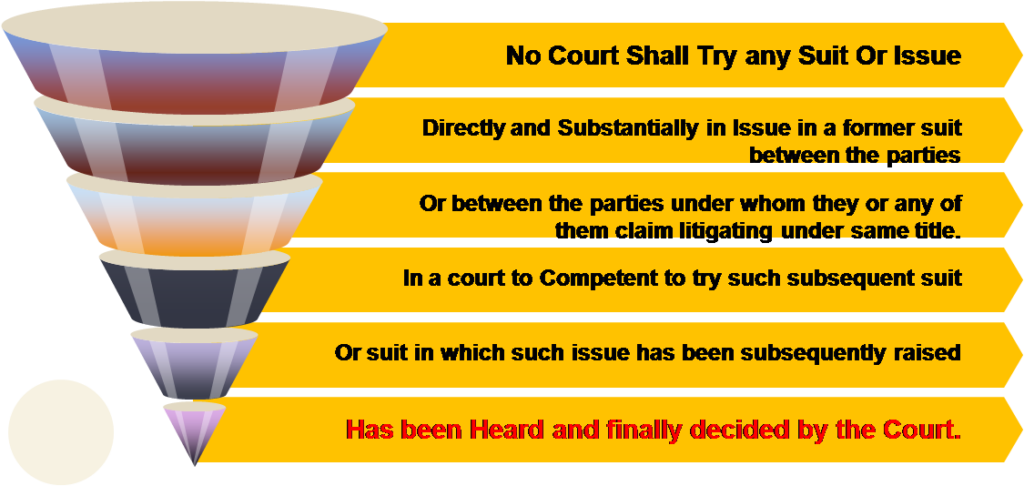
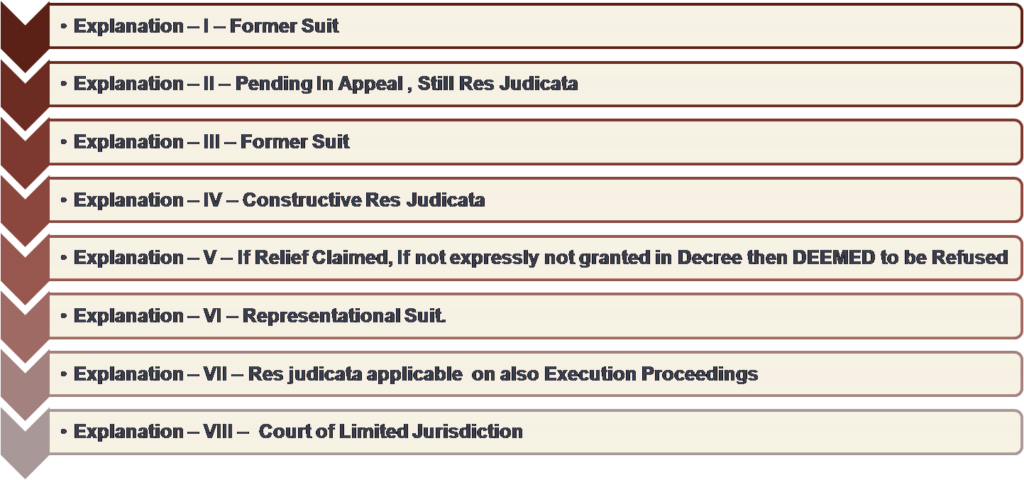
Historical Origin Of Res Judicata
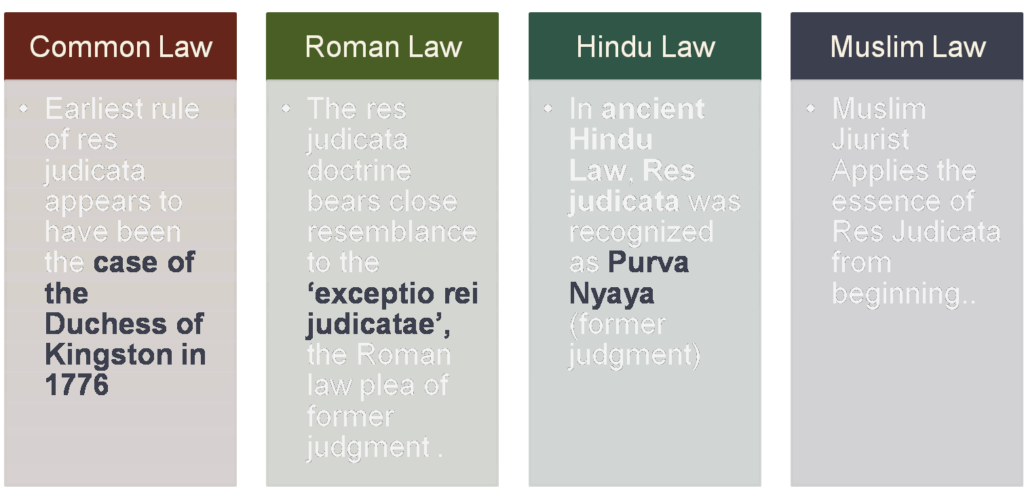
Earliest articulations within the common law of the rule of res judicata appears to have been the case of the Duchess of Kingston in 1776.
In deciding the case Sir William de Grey, C.J. laid down the following oft-quoted principle:
“the judgment of a court of concurrent jurisdiction, directly upon the point, is, as a plea, a bar, or as evidence, conclusive between the same parties, upon the same matter, directly in question in another court.”
Res Judicata is Based Upon three Latin Maxims
Res Judicata is the Latin term for “a matter already judged” and refers to the legal doctrine which prohibits the continued litigation of cases, between the same parties, which have already been heard and finally decided by a competent court. The doctrine of Res Judicata is based on various Latin maxims. The three maxims which are most important to the doctrine are as follows:
Nemo Debet Lis Vaxari Pro Eadem Causa which means that no man should be tormented twice for the same cause.
Interest Republicae Ut Sit Finis Litium which means that it is in the interest of the State that there should be an end to a litigation.
Res Judicata Pro Veritate Occipitur which means that a judicial decision must be accepted as correct.
Res Judicata is Based Upon Both Policy

Benefits of Application of Res Judicata
Res Judicata Founded On
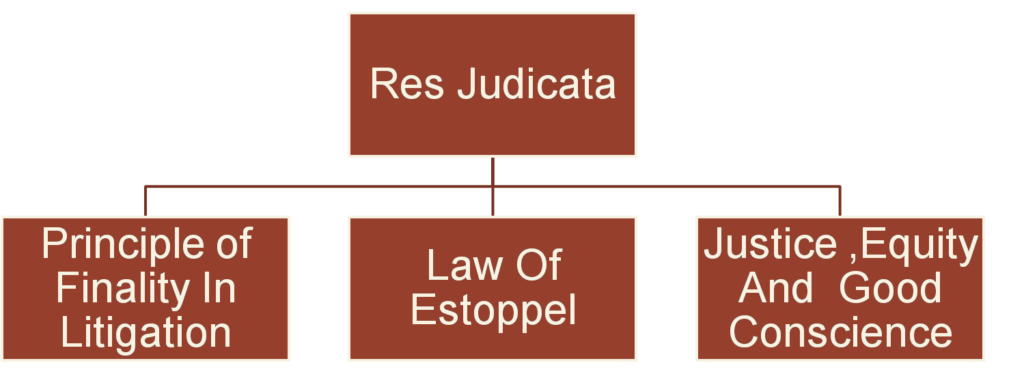
Res Judicata is Not Exhaustive

Exceptions to Res Judicata
In Raju Ramsing Vasave v. Mahesh Deorao Bhivapurkar (2008) 9 SCC 54
The Supreme Court has laid down 3 exceptions to the rule of Res Judicata
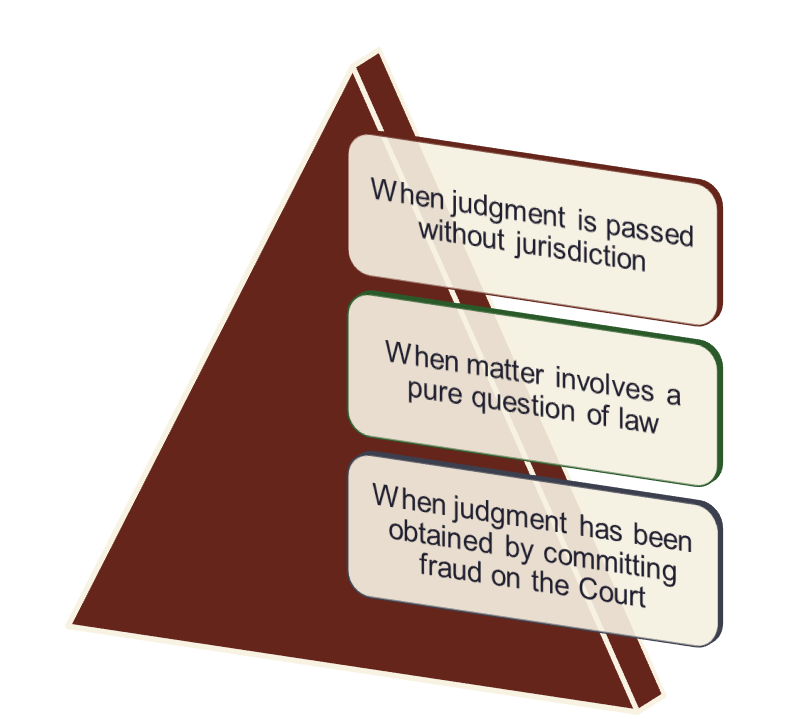
First Exceptions to Res Judicata
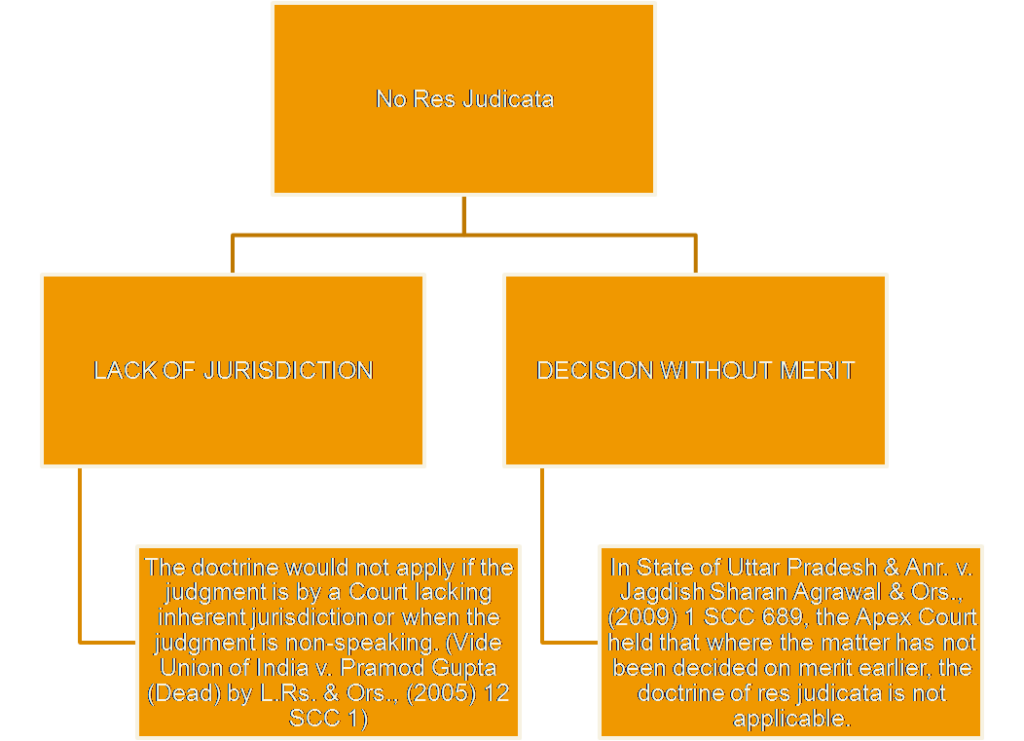
Second Exceptions to Res Judicata
When matter involves a pure question of law it operates as an Exception of Res Judicata and even when there is mixed question of facts and law and the court decides only on Technical Ground then also it serve as an exception to the Rule oF Res Judicata .
Movt Rev. PMA Metropolitan v. Moran Mar
Third Exceptions to Res Judicata
- Fraud
The principle of res judicata would not apply if the decree has been obtained by practicing misrepresentation or fraud on the court, or where the proceedings had been taken all together under a special Statute. More so, every finding in the earlier judgment would not operate as res judicata.
Section 44 of Indian Evidence Act says that if the previous judgment is proved fraud, collusion (secret or illegal cooperation) or incompetency of court then such judgement does not have the effect of res judicata.
Only an issue “directly” and “substantially”, decided in the earlier suit, would operate as res judicata. Where the decision has not been given on merit, it would not operate in case against the judgment and decree of the court below the appeal is pending in the appellate court, the judgment of the court below cannot be held to be final, and the findings recorded therein would not operate as res judicata.
In Subramanian Swami V. State of Tamilnadu AIR 2015 SC 460, the Supreme Court explained the concept of Res Judicata in the following words :
The literal meaning of “res” is everything that may form an objects of rights and includes an object, subject matter or status and “Res Judicata” literally means “a matter already adjudged, a thing judicially acted upon or decided; a thing or matter settled by judgements”.
Res Judicata Pro Veritate Occipiter is the full maxim which has over the years. Shrunk to mere “Res Judicata” which means that res judicata is accepted for truth.
The Doctrine contains the rule of conclusiveness of judgment which is based partly on the maxim of Roman Jurisprudence interest reipublicae ut sit finis lithium and nemo debet bis vexari prounaet eadam causa
Essential Conditions for Res Judicata
In the case of Lonankutty v.Thoman AIR 1976 , the 3 – Judges Bench of Supreme Court held some essential conditions must concurs so that the matter constitute as Res Judicata.
- The matter directly and substantially in Issue in the the subsequent suit or issue must be same matter which was directly and substantially in issue either actually (Explanation -III) or constructively (Explanation -IV) in the former suit.
Explanation –I is to be read with this condition.
- The former suit must have been a suit between the same parties or between parties under whom they or any of them claim. Explanation –VI is to be read with this condition.
- The parties as aforesaid must have litigated under the same title in the former suit.
- The Court which decided the former suit must have been a Court Competent to try the subsequent suit or the suit in which such issue is subsequently raised.
Explanation –II is to be read with this condition , as also Explanation –VIII
- The matter directly and substantially in issue in the subsequent suit must have been heard and finally decided by the court in the first suit.
Explanation –V is to be read with this condition. Explanation –VII extends the section to execution proceedings.
* Explanation –VIII extended the application of the section to an issue heard and decided by a court of limited jurisdiction.
From Mulla – CPC
Essential Conditions for Res Judicata (In Shorts)
The Ingredients of Res-Judicata or the Rule of Conclusiveness are:
- a) There must be Same Parties in Subsequent Suits– to prove the rule of Res-Judicata the parties in a subsequent suit must be same or between the same parties under whom they had a claim.
- b) The Title of the Suit must be the same– another important ingredient is the title must be same by the contesting parties to prove the rule of Res-Judicata.
- c) The Court must heard the case and dispose on the merit of the case– the courts should hear all the parties on merits and should gave its judgement on merits.
- d) The Subject-Matter of dispute must be same– the subject matter of dispute must be same in former and subsequent suits in order to attract this section-11, Code of Civil Procedure,1908.
e)The Court sholud be competent to try that suit– the courts must be competent to try the subsequent suit
SHEODAN SINGH V/S DARYAO KUNWAR, (1966) 3 SCR 300:
In the matter of Sheodan Singh (Supra) the Hon’ble Supreme Court of India held that a plain reading of Section 11 of the CPC, 1908 would show that to constitute a matter res judicata, the following conditions must be satisfied:
- i. The matter directly and substantially in issue in the subsequent suit must be the same matter which was directly and substantially in issue in the former suit;
- The former suit must have been a suit between the same parties or between parties under whom they or any of them claim;
iii. The parties must have litigated under the same title in the former suit;
- The court which decided the former suit must be a court competent to try the subsequent suit or the suit in which such issue is subsequently raised; and,
- The matter directly and substantially in issue in the subsequent suit must have been heard and finally decided by the court in the first suit. Further, Explanation I to Section 11 of the CPC 1908 shows that it is not the date on which the suit is filed that matters but the date on which the suit is decided, so that even if a suit was filed later, it will be a former suit if it has been decided earlier.
Essential Conditions for Res Judicata (In Shorts)
- a) Matter Directly and Substantially In Issue
The test to decide whether a matter was directly and substantially in issue in the earlier proceedings is to see if it was necessary for that issue to be decided in order for an adjudication upon the principal issue. However, every single issue framed is not a matter which is directly and substantially in issue. Thus, is becomes imperative to examine the plaint and the written statement to arrive at a conclusion as to which issues were directly and substantially in issue and which ones were merely incidentally or collaterally in issue. [21] Another manner in which such may be tested is by checking if decision on such an issue would materially affect the decision of the suit.
- b) Former Suit
The most important condition that needs to be satisfied is that the matter in issue in the subsequent suit was in issue, directly and substantially, in a former suit. The general and ordinary meaning of “suit” is a proceeding which is commenced by presentation of a plaint. [24] Ordinarily, and in more specific terms, a “suit” is a civil proceeding that is instituted by the presentation of a plaint. [25] The expression “former suit” denotes a suit that has been decided earlier in time than the suit in question, i.e. the subsequent suit, regardless of whether such a suit which was decided earlier was instituted subsequently to the suit in question or not. If two suits are instituted one after the other, and both relate to the same question in controversy, the bar of res judicata will apply even in cases where the subsequently instituted suit is decided first.
- c) Suit Between Same Parties
A ‘party’ is a person whose name appears on the record at the time of the decision. A party may be the plaintiff or defendant. The condition recognizes the general principle of law that judgments and decrees bind the parties and privies. nce the matter is heard and decided in one suit, the same cannot be agitated again by the same parties, their legal representatives or successors. Res judicata binds in a subsequent suit, the same parties to the former suit, the legal representatives of such parties or anyone claiming under such parties. Further, even if a subsequent suit is brought about in a different form or under a different guise, but seeking to agitate the same matter as was decided in the former suit, it will be barred by res judicata. E.g. A sues B for breach of contract. A’s suit is dismissed. A cannot file a fresh suit against B for claiming damages.
Res judicata also operates between co-plaintiffs and co-defendants
- d) Matter To Be Decided By A Competent Court
It is essentially for res judicata to operate against the subsequent, that the former suit should have been decided by a court “competent to try” the subsequent suit. The expression “competent to try” means “competent to try the subsequent suit if brought at the time the first suit was brought”.
Before Explanation VIII was added to S. 11, the position was that the Court which decided the former suit must have been competent to decide the subsequent suit as well, and if it was not, then res judicata would not apply. However, with the insertion of Explanation VIII, even if the Court which decided the former suit is not competent to decide the subsequent suit, res judicata will still be applicable provided that the former suit was decided by a competent Court.
An order Passed without Jurisdiction would be nullity. It will be coram non judice. It is non est in the eye of law.
- d) Matter To Be Decided By A Competent Court
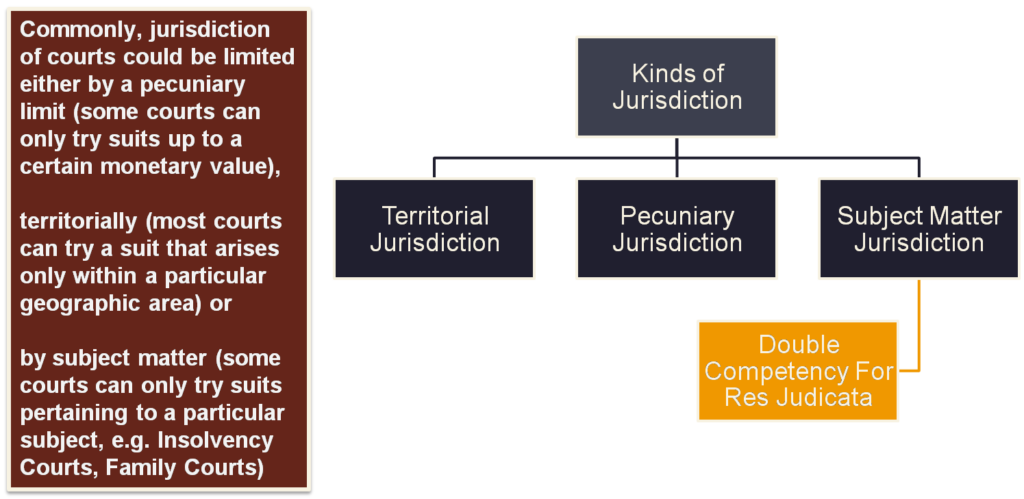
For a judgment to apply as res judicata, firstly, the decision in the previous suit must have been rendered by a court which had pecuniary and subject matter jurisdiction to try that suit.Secondly, the previous court must also have had the jurisdiction to try and determine the subsequent suit i.e. the two courts must have concurrent jurisdiction.
Pandurang Mahadeo Kavade v. Annaji Balwant Bokil :AIR 1971 SC 2228. The bar of pecuniary jurisdiction is not a case of inherent lack now. See: (1978) 1 AnWR 440 OR (1978) 1 APLJ 63: “the decision of a Court shall not be reversed purely on technical grounds like lack of territorial or pecuniary jurisdiction unless it has resulted in failure of justice and the objection to the lack of jurisdiction was taken at the earliest possible time” as cited in Kohday Engineering Ltd. v. Bharat Dynamics Ltd, 1993 (2) ALT 432
- e) The Matter Should Be Heard and Finally Decided
For res judicata to be applied, it is necessary that that the matter should have been heard and finally decided in the former suit, and whether such decision be right or wrong is of consequence. [31] If an opinion is expressed on issues not material to the decision, then res judicata will not apply. [32] The matters which are directly and substantially in issue in the subsequent suit must have been heard by the Court in the former suit and a final decision on the same must have been delivered. In such cases, res judicata will apply to the subsequent suit. Such a provision also applies to former suits that were disposed of ex parte, provided that notifications were suitably issued to the party in question. But if a suit is dismissed on a technical ground, such a non-joinder of necessary party, it would not operate as res judicata. [33

A matter will be said to have been heard and finally decided notwithstanding that the former suit was disposed of in any of following ways.
- Ex parte
- By dismissal under Order – XVII Rule – 3 but not when dismissal under O- XVII , R- 1 for failure to pay adjournment cost
- By a decree or an award
- By oath tendered under sec -8 of the Indian oath act -187
- By dismissal owing to plaintiffs failure to adduce evidence at the hearing.
Consent/Compromise Decrees
Section 11 of the CPC requires a suit to have been “heard and decided” by a court in order to apply as res judicata in a subsequent suit. A consent/compromise Decree will not operate as Res Judicata But operates as Estoppel By Judgement.
Raghunandan v Ali Hussain Sabir 2008 SCC
RES JUDICATA AND ESTOPPEL
Res judicata is sometimes treated as a part of the doctrine of estoppels, but the two are essentially different. Estoppel is a part of the law of evidence and prevents a person from saying one thing at one time and contradicting it later, while res judicata precludes a man from avowing the same thing in successive litigation. The operation of the doctrine of res judicata is the transformation of a question of fact into a question of law. By applying the principles of res judicata, a court cannot be vested with a jurisdiction not vested by the law.
Mahmud J in Sita Ram v Amir Begam said: Perhaps the shortest way to describe the difference between the plea of res judicata and an estoppels, is to say that whilst the former prohibits the court from entering into an inquiry at all as to matter already adjudicated upon, the latter prohibits a party after the inquiry has already been entered upon, from providing anything which would contradict his own previous declarations or act, to the prejudice of another party who, relying upon those declarations or acts, has altered his position. In other words, res judicata prohibits an inquiry in limine whilst an estoppels is only a piece of evidence.
NON APPLICATION OF RES JUDICATA
1)Habeas Corpus Petitions Sunil Dutt V Union of India: Held that habeas corpus, filed under fresh grounds and changed circumstances will not be barred by a previous such petition.
2)Dismissal of Writ Petition in Limine Pujaril Bal V Madan Gopal: Held Res Judicata not applicable when dismissed in limine (without speaking orders) or on grounds of laches or availability of alternative remedies.
3)Matter collaterally and incidentally in issue doesn’t operate as Res Judicata – Sayed Mhd V. Musa Ummer
4) Res Judicata not applicable to IT Proceedings or fixing of fair rent proceedings
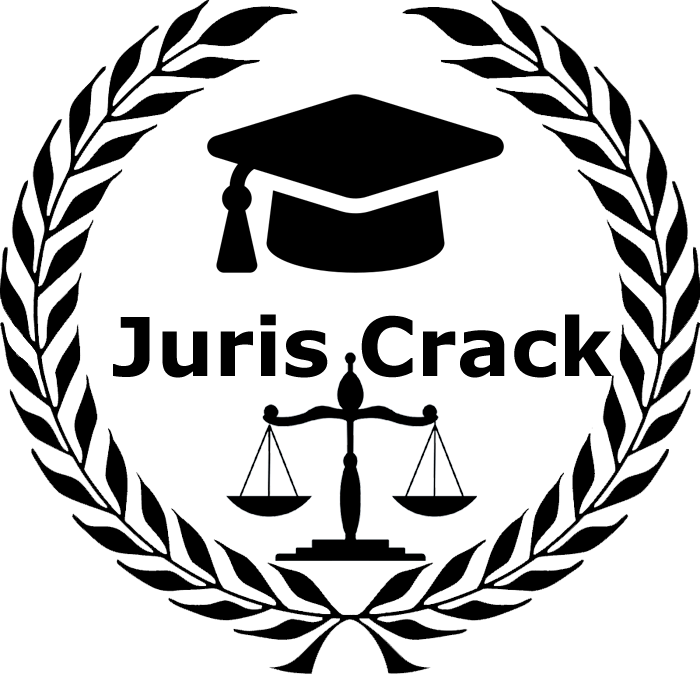




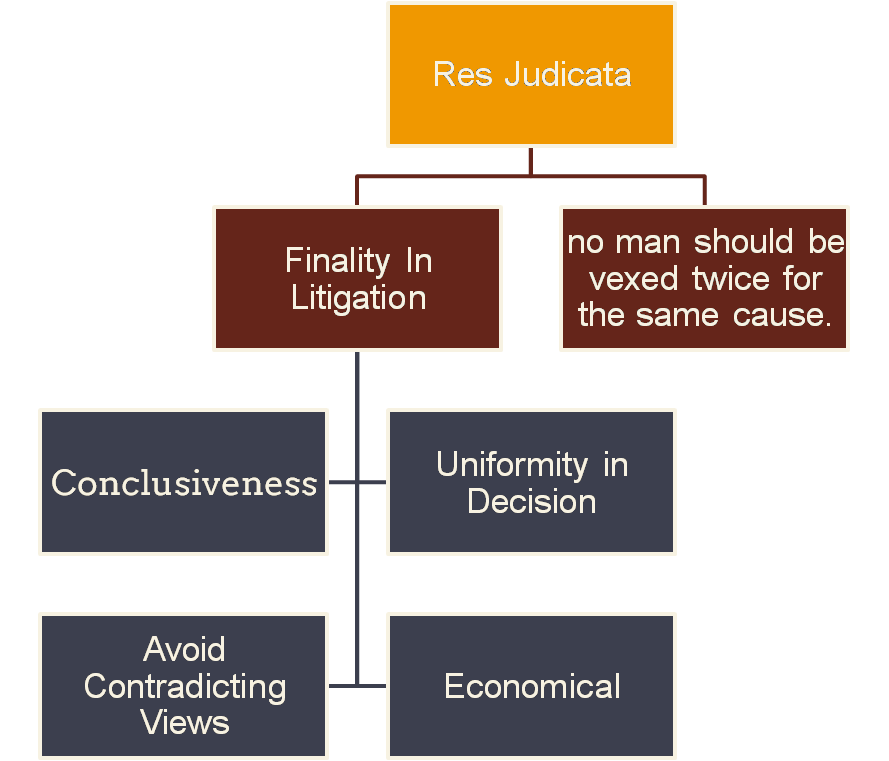
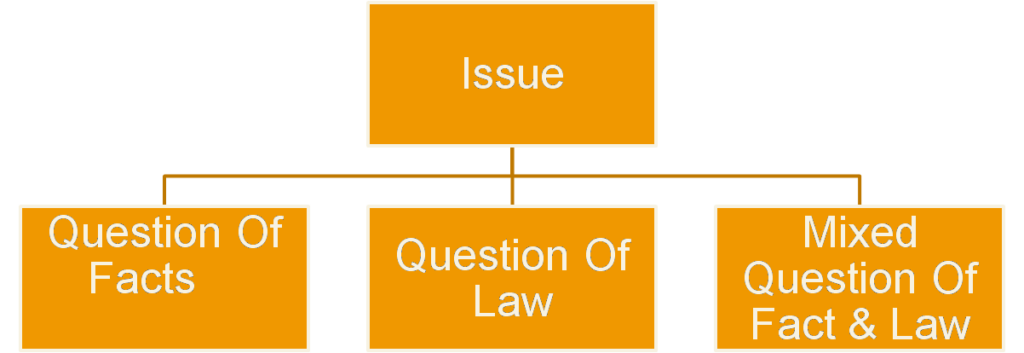



No comment